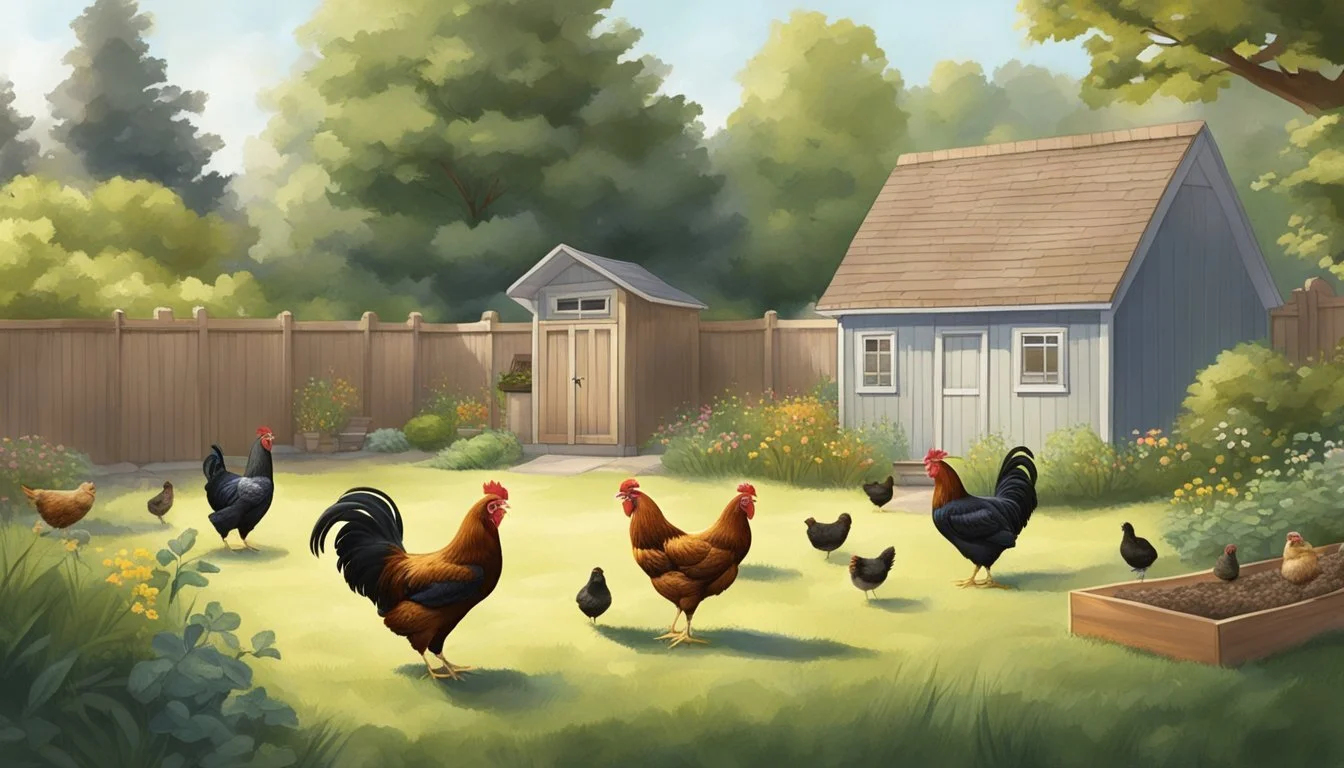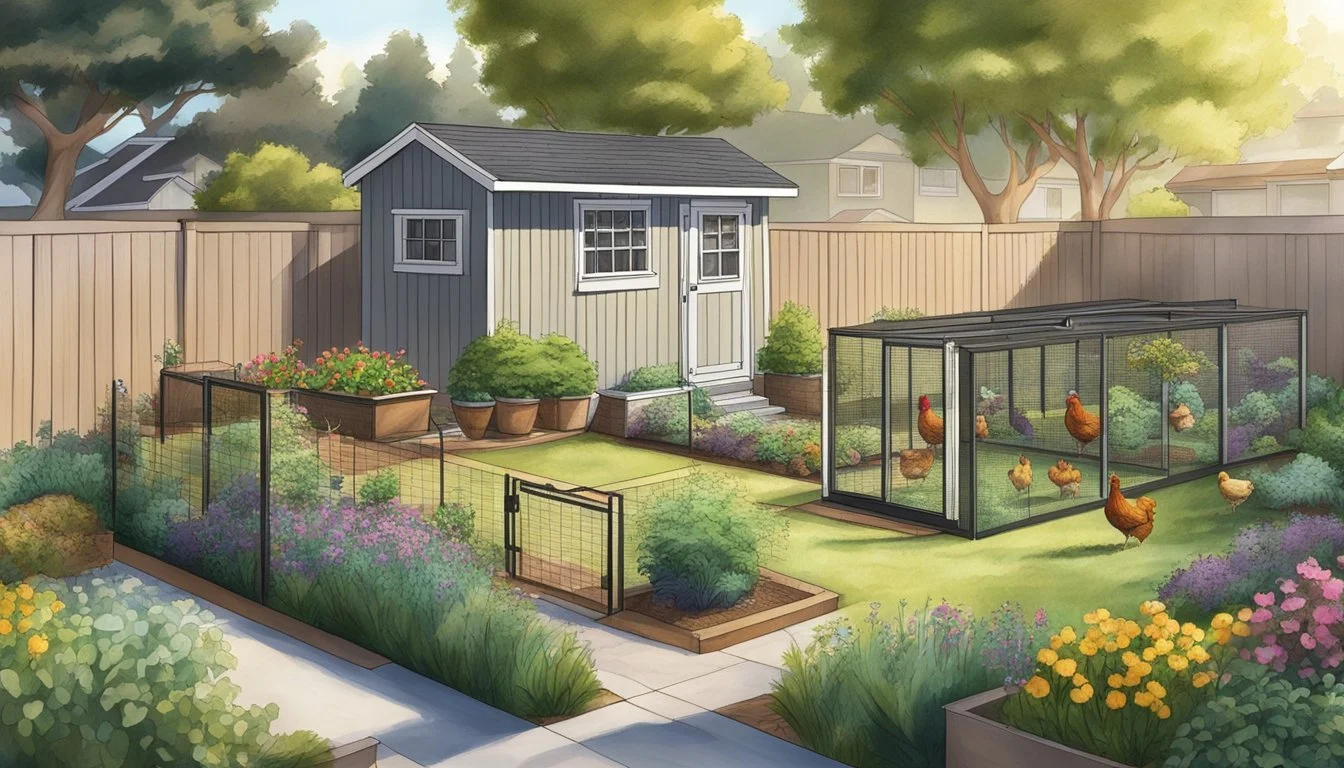Keeping Backyard Chickens in San Mateo, CA
Essential Guidelines for Urban Poultry Farming
Keeping backyard chickens is a popular trend amongst residents who wish to engage in more sustainable living practices, and San Mateo, California, is no exception. In San Mateo, both the city and county have embraced the idea by implementing specific ordinances that regulate the keeping of chickens within residential areas. This approach ensures that while residents may enjoy the benefits of fresh eggs and companionship, the well-being of the community and the chickens are not compromised.
In the city of San Mateo, the local ordinance stipulates that residential lots of 2,500 square feet or more are allowed to keep chickens. Lots that measure between 2,500 and 7,500 square feet are permitted a maximum of six birds. These regulations are designed to provide ample space for the chickens, thereby reducing potential nuisances and maintaining public health standards.
With the increasing interest in urban homesteading, understanding the legal framework for keeping backyard chickens in San Mateo is essential for any aspiring poultry enthusiast. The guidelines set forth by San Mateo County offer clarity on the number of chickens allowed, coop requirements, and the importance of keeping the birds within designated property boundaries. It's critical for residents to familiarize themselves with these rules to ensure harmony between human and poultry inhabitants.
Understanding Local Chicken Laws
Navigating the complexities of local chicken laws in San Mateo County requires awareness of zoning ordinances, permitting processes, and the regulations affecting the number and types of poultry one may keep.
San Mateo County Zoning and Ordinances
In San Mateo County, zoning laws dictate where chickens can be kept. Residential lots sized 2,500 sq. ft. or larger are eligible for chicken keeping, with distinct rules for lots under 7,500 sq. ft. Within city limits, the regulations may vary, so residents must consult local codes.
Permitting Process for Keeping Chickens
To keep chickens legally in San Mateo, homeowners may be required to obtain a permit. The permitting process includes submitting an application to the municipality and ensuring compliance with all local ordinances pertaining to backyard poultry.
Restrictions on Number and Types of Chickens
For residential lots larger than 2,500 sq. ft. but smaller than 7,500 sq. ft., a maximum of six chickens is allowed. Roosters are often prohibited due to noise concerns, restricting residents to keeping only hens and chicks.
Comparison to Other California Cities
San Mateo's chicken ordinances are consistent with many California cities like Oakland and San Jose, yet more restrictive than cities such as Los Angeles, where residents may keep more birds. It's crucial to refer to a local chicken law map or database for specifics.
Legal Consequences for Non-Compliance
Failure to adhere to the San Mateo chicken ordinance may result in legal consequences, which can include fines or the removal of the animals. Compliance is strictly enforced to prevent public nuisance issues.
Considerations for Neighboring Residences
Keeping chickens near neighboring residences requires maintaining a proper distance from property lines, usually mandated by local code, to minimize disturbances. Enclosures must be designed to prevent any potential nuisance or neglect.
Connect with Local Community
For those new to backyard chickens, connecting with community resources such as local community gardens or online forums like The City Chicken can offer valuable insights and support.
Additional Local Ordinance Information
Further details on chicken keeping in specific localities within the county, such as Half Moon Bay, Hillsborough, or Belmont, can be found through municipal websites or at the office of the San Mateo County zoning and planning department.
Setting Up Your Chicken Coop
Before embarking on the rewarding journey of raising backyard chickens, prospective poultry keepers in San Mateo should pay attention to the specific local guidelines. Ensuring the coop meets the size requirements and is properly located and protected is a critical factor for success.
Choosing the Right Location
The optimal location for a chicken coop in a residential lot is a dry, elevated area to prevent flooding. It should be situated away from property lines to adhere to local ordinances and to minimize disturbance to neighbors. Adequate sunlight and shade are important for the birds' health, so positioning the coop to receive both is advisable.
Coop Design and Size Requirements
In San Mateo, the coop’s design should conform to the minimum lot size requirement of 2,500 sq. ft. for backyard chickens. If the lot size is between 2,500 and 7,500 sq. ft., a maximum of six birds are allowed. The coop must be solidly built with ample space for each chicken, generally 2-3 square feet per bird inside the coop and about 10 square feet per bird in an outside run.
Protecting Chickens from Predators
A sturdy fence surrounding the coop and run is essential to protect chickens from predators like foxes and raccoons. The coop should be secured with hardware cloth rather than chicken wire to prevent predators from getting in. Additional measures include locking coop doors at night.
Maintaining a Healthy Living Environment
A chicken coop must be kept clean and sanitary to prevent disease. It should be well-ventilated and have a design that allows for easy cleaning. Regular removal of waste and replacement of bedding will help maintain the health of the chickens. Providing nesting boxes and perches will also contribute to a suitable living environment.
Local Provisions for Other Backyard Animals
San Mateo residents interested in keeping other backyard animals should be aware of local ordinances governing the keeping of ducks, goats, bees, and other livestock. Similar to chickens, these animals require their own specific housing and space requirements. For instance, ducks also require access to water for bathing. Considering local guidelines before setting up habitats for any additional backyard animals is crucial.
By following these specific guidelines, residents can create a supportive and legal environment for their backyard chickens.
Best Practices for Raising Chickens
Effective chicken care requires attention to their diet, consistent health monitoring, careful breeding practices, commitment to cleanliness, and active community involvement. When carefully managed, these elements ensure a thriving backyard flock in San Mateo, CA.
Feeding and Nutrition
Chickens require a balanced diet to maintain their health and egg production. Feed should include:
Starter feed crumbles (18-20%) for chicks aged 0-8 weeks
Starter/grower (16-18%) for birds 8-14 weeks old
Finisher feed (16%) for the 15-18 week age group
Using rat-proof containers for feed storage maintains sanitation and prevents rodent access.
Health Checks and Preventing Diseases
Regular health assessments are critical for early detection of diseases. Keepers should:
Monitor for signs of illness, such as lethargy or abnormal droppings
Vaccinate chicks against common diseases
Establish quarantine protocols for new or sick birds
A clean environment and proper sanitation practices dramatically reduce disease risks.
Breeding and Flock Expansion
Responsible breeding entails understanding genetic traits and managing flock numbers. Breeders should:
Select healthy birds for reproduction
Provide a secure nesting area for hens
Monitor the health of hens and chicks during and after the breeding process
Educational resources from community gardens can offer guidance on best breeding practices.
Waste Management and Sanitation
Maintaining a clean coop is non-negotiable. To ensure sanitary conditions:
Remove droppings regularly and dispose of them properly
Clean the coop thoroughly on a scheduled basis
Use proper bedding materials to absorb moisture and odor
Effective waste management prevents odor and pest issues in residential areas.
Community Engagement and Education
A well-informed community promotes successful backyard chicken keeping. Engagement can include:
Participating in local workshops or educational programs
Sharing best practices with fellow poultry enthusiasts
Consulting with community gardens for collective knowledge
Ongoing education strengthens communal understanding and support for backyard chicken keepers.
Ancillary Information
In San Mateo, keeping backyard chickens requires adherence to specific guidelines designed to maintain community standards and animal welfare. This section provides essential resources for chicken keepers and advice on managing noise and waste, crucial for harmonious urban poultry husbandry.
Resources for Chicken Keepers
Chicken keepers in San Mateo have access to a variety of resources to ensure they are in compliance with local ordinances and to support the well-being of their poultry. These include:
Local Ordinance Documents: Detailed information on regulations, including setback requirements, can be found in the Poultry Ordinance provided by the County of San Mateo.
Educational Materials: The Peninsula Humane Society & SPCA offers guidance on proper care and keeping of backyard birds.
Suppliers: Local suppliers, known informally as "the city chicken," provide feed, coops, and other necessary equipment tailored to small-scale chicken rearing.
Managing Noise and Waste
Effective management of noise and waste is vital to avoid public nuisance complaints and to maintain a clean and healthy environment for both chickens and residents.
Noise: Choose hen breeds known for being quieter to minimize disturbance. Implementing a regular feeding schedule can reduce noise since chickens are often noisiest when hungry.
Waste Management:
Regular Cleaning: Clean the coop frequently to mitigate odors and flies.
Composting: Chicken manure can be composted and used as valuable fertilizer for gardens, but it must be handled properly to prevent odor issues.
Setbacks: Adhere to setback requirements to keep coops a suitable distance from neighboring properties.
Chicken keepers should seek additional information from local government websites or community groups to remain updated on best practices and any changes in local regulations.






